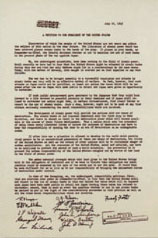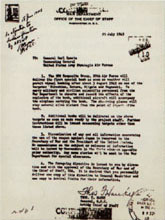Japan at that Time
Japan was warring intensely against China, the U.S. and other countries.
During early Showa, Japan was in a deep depression and the people were increasingly dissatisfied with the government. Some militarists believed that having access to the abundant natural resources in north-eastern China (the province of Manchuria) forcibly created the country Manchuria, intending to rule it as they pleased. The Chinese people began to resist fiercely. Thus Japan and China began a war that dragged on over ten years.
Also, in 1941, Japan carried out a surprise attack on Pearl Harbor in Hawaii, declaring war against the U.S., Britain, and other countries. This was the beginning of what was called the Pacific War.
Japan had the advantage initially, but then lost a succession of battles for Pacific islands and Southeast Asian regions. In 1944, American warplanes began invading Japanese air space and dropping bombs on Japanese cities.
●The spreading war enveloped the Pacific Ocean.
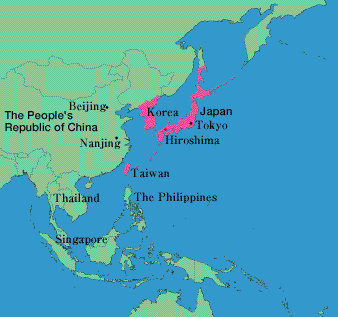
The entire country was caught up in the war structure.
In 1938, the government enacted the National Mobilization Law to enable it to make war the highest priority for the utilization of all persons and things. Denied the right to criticize the war, the majority of the Japanese believed the government's announcements and the government-controlled newspaper and radio news. Life was very difficult. School instruction was tailored to implant the desire to help win the war. The desire to "Fight until we win" pervaded the entire country.

Poster announcing the "Metal Collection Order"As metals essential to weapons manufacture grew scarce, the military took all metal products, from temple bells to household pots.
Around 1942
Collection of Hiroshima Municipal Archives

Young Air Force Pilots
Small Citizens Weekly,
Nov. 12, 1944 issue
Courtesy of Asahi Shimbun

Youth Tankman
Small Citizens Weekly,
March 11, 1945 issue
Courtesy of Asahi Shimbun
In 1941, elementary schools became "national schools."
Children were called "small citizens" and the content of children's books was designed to foster support for the war.
Hiroshima and the War
Largest city in the Chugoku-Shikoku Region
Since Mori Terumoto, a lord during the Age of Civil Wars (about 400 years ago) built a castle and called the surrounding area "Hiroshima," it has developed as the center of transport and economy in the Chugoku Region. In later years, the town grew by creating landfills. When it became "Hiroshima City" in 1889, it was one of Japan's first official cities.

Courtesy of Hiroshima Municipal Archives
Hiroshima Castle Tower before the Atomic Bombing Castle town Hiroshima developed around Hiroshima Castle. Part of the castle was demolished during the Meiji Restoration, but because the tower was considered an important structure, it was retained and designated a national treasure in 1931. However, the tower completely collapsed and burned in the atomic bombing. The present castle tower was reconstructed in 1958.
Military City Hiroshima
Though Hiroshima City's many schools earned it the name "education city," it equally deserved to be called "military city." In 1871, Hiroshima became one of the first Japanese cities to have a military base. Particularly during the first Sino-Japanese War (1894-1895) and the Russo-Japanese War (1904-1905), soldiers and goods were dispatched from Ujina Port in the city to the war front. As receptacle to an endless flow of people and goods, Hiroshima flourished. Military facilities cropped up around the city. By 1943, the year of Sadako's birth, the military occupied around 10% of the city area.
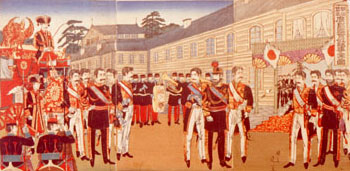
The Meiji Emperor in Hiroshima during the Sino-Japanese WarDuring the Sino-Japanese War, the Imperial Diet convened in Hiroshima, making the city a kind of temporary capital of Japan.
"The Hiroshima Provisional Diet Building";
Woodblock print
1894 Collection of Hiroshima Central City Library
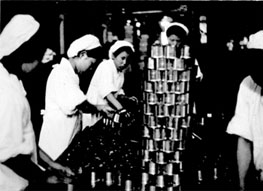
Food canning at the Hiroshima Army Provisions Depot (making food and other goods for the army). Japan's only military canning plant was in Hiroshima.
Collection of Shigeru Uchiyama
Courtesy of Hiroshima City Museum of History and Traditional Crafts
People's Lives during the War
"Do without until we win."
As the war dragged on, life got harder and harder. No longer could people freely buy the necessities of life─food, clothing, and fuel. The government issued people coupons, which they exchanged for rations.
Keeping their spirits up with such slogans as "Do without until we win" and "Extravagance is the enemy," people put up with inconvenience.
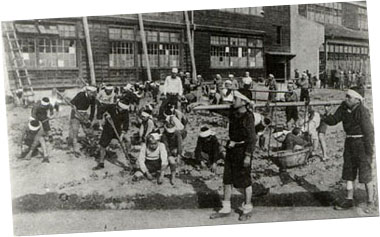
Digging a vegetable garden in the schoolyardTo make up for a shortage of food, even schoolyards were turned to fields where students grew potatoes, pumpkins, etc.
Nobori-cho Elementary School, 1945
Collection of Hiroko Yamanoue
Courtesy of Hiroshima Municipal Archives
Development of the Atomic Bomb
Hitler and the Atomic Bomb
While Japan was fighting the Pacific War, World War II was engulfing Europe. Led by Adolf Hitler, Nazi Germany invaded its neighboring countries one by one, while battling Britain, France and the other Allied countries. Interested in the possibility of generating massive energy by splitting uranium nuclei, Hitler was preparing research to build an atomic bomb.
Worried that Germany, who was persecuting Jews throughout Europe, would soon have an atomic bomb, Leo Szilard and other scientists wrote the U.S. President Franklin D. Roosevelt a letter urging research into such a bomb. World-renowned scientist/physicist and Nobel Prize recipient Albert Einstein put his signature on the letter.
●Understanding the Mechanism of Nuclear Fission
The Manhattan Project
With the approval of President Roosevelt, the U.S. began an atomic bomb development program that later came to be known as the Manhattan Project. The development cost roughly $2 billion, an enormous amount at that time, and required the participation of more than 120,000 persons.
Successful Atomic Bomb Test in July
Even after the U.S. government learned that Germany had given up on the attempt to develop an atomic bomb, it kept the project in gear. On July 16, 1945, the world's first atomic bomb test was carried out in the desert near Alamogordo, New Mexico.

Before the test, a 30-meter steel tower stood on this spot. The test destroyed the tower except for part of the base. The atomic bomb produced far more destructive power than the scientists had imagined.
September 1945
Courtesy of the Los Alamos National Labortory
The Order to Drop the Atomic Bomb
After Hitler's suicide in May 1945, Germany surrendered unconditionally. Some scientists, who had believed that the purpose of developing the bomb was to stop Nazi Germany, wrote the U.S. government report opposing use of the bomb without warning and requesting a demonstration use. The U.S. government ignored the report; on July 25, the order to drop the atomic bomb was issued.
Click on the above photos to read the text of the letters.
Atom: the smallest unit of matter
Nuclear fission
- When a neutron strikes a nucleus at the center of a uranium atom, the nucleus shakes violently, constricts, then divides.
- When the nucleus divides, neutrons are emitted with great energy.
- When the neutron flies off, it strikes other nuclei.
- 1., 2., and 3. are repeated.
As the fission splits many atoms each instant, it releases a tremendous amount of energy. The atomic bomb turns this energy into a weapon.
The fission
※This fission process needs a certain
amount of uranium or other nuclear fuel
before it can repeat itself. That amount is called "critical mass."
Uranium has
two primary isotopes, U-238 and U-235. These normally appear in a ratio
of 99.3% for U-238 to 0.7% for U-235. To make uranium fuel for a bomb, the
uranium must be "enriched," that is, have a higher percentage
of U-235. The U-235 starts the nuclear chain reaction by sending out many
neutrons to hit atomic nuclei.
July 17, 1945
A PETITION TO THE PRESIDENT OF THE UNITED STATES
Discoveries of which the people of the United States are not aware may affect the welfare of this nation in the near future. The liberation of atomic power which has been achieved places atomic bombs in the hands of the Army. It places in your hands, as Commander-in-Chief, the fateful decision whether or not to sanction the use of such bombs in the present phase of the war against Japan.
We, the undersigned scientists, have been working in the field of atomic power. Until recently we have had to fear that the United States might be attacked by atomic bombs during this war and that her only defence might lie in a counterattack by the same means. Today, with the defeat of Germany, this danger is averted and we feel impelled to say what follows:
The war has to be brought speedily to a successful conclusion and attacks by atomic bombs may very well be an effective method of warfare. We feel, however, that such attacks on Japan could not be justified, at least not unless the terms which will be imposed after the war on Japan were made public in detail and Japan were given opportunity to surrender.
If such public announcement gave assurance to the Japanese that they could look forward to a life devoted to peaceful pursuits in their homeland and if Japan still refused to surrender our nation might then, in certain circumstances, find itself forced to resort to the use of atomic bombs. Such a step, however, ought not to be made at any time without seriously considering the moral responsibilities which are involved.
The development of atomic power will provide the nations with new means of destruction. The atomic bombs at our disposal represent only the first step in this direction, and there is almost no limit to the destructive power which will become available in the course of their future development. Thus a nation which sets the precedent of using these newly liberated forces of nature for purposes of destruction may have to bear the responsibility of opening the door to an era of devastation on an unimaginable scale.
If after this war a situation is allowed to develop in the world which permits rival powers to be in uncontrolled possession of these new means of destruction, the cities of the United States as well as the cities of other nations will be in continuous danger of sudden annihilation. All the resources of the United States, moral and material, may have to be mobilised to prevent the advent of such a world situation. Its prevention is at present the solemn responsibility of the United States - singled out by virtue of her lead in the field of atomic power.
The added material strength which this lead gives to the United States brings with it the obligation of restraint and if we were to violate this obligation our moral position would be weakened in the eyes of the world and in our own eyes. It would then be more difficult for us to live up to our responsibility of bringing the unloosened forces of destruction under control.
In view of the foregoing, we, the undersigned, respectfully petition: first, that you exercise your power as Commander-in-Chief, to rule that the United States shall not resort to the use of atomic bombs in this war unless the terms which will be imposed upon Japan have been made public in detail and Japan knowing there terms has refused to surrender; second, that in such an event the question whether or not to use atomic bombs be decided by you in the light of the considerations presented in this petition as well as all the other moral responsibilities which are involved.
25 July 1945
TO: General Carl Spaatz
Commanding General
United States Army Strategic Air Forces
- The 509 Composite Group, 20th Air Force will deliver its first special bomb as soon as weather will permit visual bombing after about 3 August 1945 on one of the targets: Hiroshima, Kokura, Niigata, Nagasaki. To carry military and civilian scientific personnel from the War Department to observe and record the effects of the explosion of the bomb, additional aircraft will accompany the airplane carrying the bomb. The observing planes will stay several miles distant from the point of impact of the bomb.
- Additional bombs will be delivered on the above targets as soon as made ready by the project staff. Further instructions will be issued concerning targets other than those listed above.
- Dissemination of any and all information concerning the use of the weapon against Japan is reserved to the Secretary of War and the President of the United States. Communiques on the subject or releases of information will be issued by Commanders in the field without specific prior authority. Any news stories will be sent to the War Department for special clearance.
- The foregoing directive is issued to you by direction and with the approval of the Secretary of War and of the Chief of Staff, USA. It is desired that you personally deliver one copy of this directive to General MacArthur and one copy to Admiral Nimitz for their information.
THOS. T. HANDY
General, G.S.C.
Acting Chief of Staff


